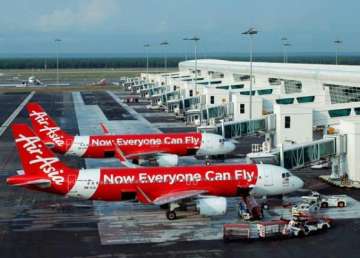AirAsia missing plane's request to change course was denied
Surabaya (Indonesia): The pilots sought permission to climb above threatening clouds. Air traffic control couldn't say yes immediately -- there was no room. Six other airliners were crowding the airspace, forcing AirAsia Flight 8501 to

Surabaya (Indonesia): The pilots sought permission to climb above threatening clouds. Air traffic control couldn't say yes immediately -- there was no room. Six other airliners were crowding the airspace, forcing AirAsia Flight 8501 to remain at a lower altitude.
Minutes later, the jet carrying 162 people was gone from the radar without ever issuing a distress signal. The plane is believed to have crashed into Indonesia's Java Sea, but broad aerial surveys on Monday turned up no firm evidence of the missing Airbus A320-200.
Searchers spotted two oily patches and floating objects in separate locations, but no one knew whether any of it was related to the plane that vanished Sunday halfway into what should have been a two-hour hop from Surabaya, Indonesia, to Singapore. Officials saw little reason to believe the flight met anything but a grim fate.
READ MORE: Search for missing AirAsia plane enters third day
Based on the plane's last known coordinates, the aircraft probably crashed into the water and "is at the bottom of the sea," Indonesia search-and-rescue chief Henry Bambang Soelistyo said. Still, searchers planned to expand their efforts onto land on Tuesday.
The last communication from the cockpit to air traffic control was a request by one of the pilots to climb from 32,000 feet (9,754 meters) to 38,000 feet (11,582 meters) because of the weather. The tower was not able to immediately comply because of the other planes, said Bambang Tjahjono, director of the state-owned company in charge of air traffic control.
The twin-engine, single-aisle plane was last seen on radar four minutes after the final communication.
When planning a route prior to takeoff, pilots try to avoid thunderstorms. But if one pops up during the trip, or crews encounter rough turbulence, they routinely ask to fly around storms or move below or above the turbulence.
A storm alone isn't going to bring down a modern plane designed to withstand severe weather. But weather paired with a pilot error or a mechanical failure could be disastrous. It's like a car driving on a highway during a thunderstorm. Plenty of vehicles get through bad weather safely but one that gets a flat tire or takes a turn too fast might crash.
Pilots rely on sophisticated weather-radar systems that include a dashboard display of storms and clouds, as well as reports from other crews, to steer around dangerous weather.
"A lot more information is available to pilots in the cockpit about weather than it ever was," said Deborah Hersman, former chairman of the U.S. National Transportation Safety Board. But the technology has limits and sometimes information about storms "can be a little bit stale."
At least 15 ships, seven aircraft and four helicopters were looking for the jet, Indonesian search-and-rescue spokesman Jusuf Latif said. Most of the craft were Indonesian but Singapore, Malaysia and Australia contributed to the effort. Aircraft from Thailand were awaiting clearance to join the search.
Those numbers do not include Indonesian warships taking part in the search. Many fishermen from Belitung island also helped, and all vessels in that area were alerted to watch for anything that could be linked to the plane.
The U.S. State Department said Monday that Indonesia had asked for help locating the jet, and American officials were reviewing the request. The Pentagon said any assistance could include detection equipment deployed by air, surface and sub-surface.
Jakarta's air force base commander, Rear Marshal Dwi Putranto, said an Australian Orion aircraft had detected "suspicious" objects near an island about 100 miles (160 kilometers) off central Kalimantan. That's about 700 miles (1,120 kilometers) from where the plane lost contact, but within Monday's greatly expanded search area.
"However, we cannot be sure whether it is part of the missing AirAsia plane," Putranto said. "We are now moving in that direction."
Air Force spokesman Rear Marshal Hadi Tjahnanto told MetroTV that an Indonesian helicopter spotted two oil patches in the Java Sea east of Belitung island, much closer to where the plane lost contact. He said oil samples would be collected and analyzed.
An Associated Press photographer flew in a C-130 transport carrier with Indonesia's Air Force for 10 hours Monday over a large section of the search area between Kalimantan and Belitung. The flight was bumpy and rainy at times. It flew low, at 1,500 feet, easily spotting waves, ships and fishermen, but there was no sign of the plane.
The suspected crash caps an astonishingly tragic year for air travel in Southeast Asia, and Malaysia in particular. Malaysia-based AirAsia's loss comes on top of the still-unexplained disappearance of Malaysia Airlines Flight 370 in March with 239 people aboard, and the downing of Malaysia Airlines Flight 17 in July over Ukraine, which killed all 298 passengers and crew.
"Until today, we have never lost a life," AirAsia group CEO Tony Fernandes told reporters. "But I think that any airline CEO who says he can guarantee that his airline is 100 percent safe is not accurate."
Indonesian President Joko "Jokowi" Widodo ordered an immediate review of all aviation procedures.
Nearly all the passengers and crew are Indonesians, who are frequent visitors to Singapore, particularly on holidays.
Few believe this search will be as perplexing as the ongoing one for Flight 370, where what happened onboard remains a total mystery. Authorities suspect the plane was deliberately diverted by someone on board and ultimately lost in a remote area of the Indian Ocean with notoriously deep water. Flight 8501 vanished over a heavily travelled sea that is relatively shallow, with no sign of foul play.